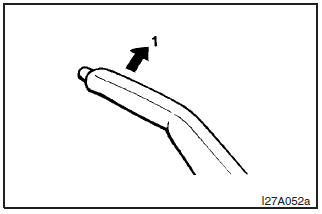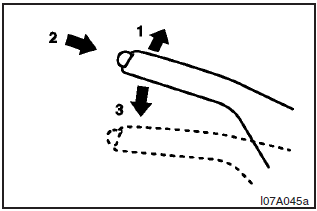Parking brake

To park the vehicle, first bring it to a complete stop, fully engage the parking brake and then move the gear shift lever to 1st (on an uphill) or Reverse (on a downhill) position, for vehicles with a manual transmission or set the selector lever to “P” (PARK) position on automatic transmission vehicles.
To apply
1- Pull the lever up without pushing the button at the end of the hand grip.

To release
1- Pull the lever up slightly.
2- Push the button at the end of the hand grip.
3- Push the lever downward.
NOTE
To prevent the parking brake from being released unintentionally, the lever must be pulled upward slightly before it can be pushed downward. Simply pressing the button does not enable the lever to be pushed downward.
When parking on a hill, apply the parking brake and turn the front wheels towards the kerb on a downhill grade, away from the kerb on an uphill grade.
CAUTION
Before driving, be sure that the parking brake is fully released and the brake warning lamp is off.
If a vehicle is driven without releasing the parking brake, the brake will be overheated, resulting in ineffective braking and possible brake failure.
See also:
Keyless entry system
Press the remote control switch, and all doors and the rear hatch will be locked
or unlocked as desired.
It is also possible to operate the door outside rear-view mirrors.
1- LOCK switch
2- UN ...
Washer fluid
Open the washer fluid reservoir cap and check the level of washer fluid with
the dipstick.
If the level is low, replenish the container with washer fluid.
NOTE
• The washer fluid container s ...
To lock
Press the LOCK switch (1). All the doors and rear hatch will be locked. The turn-signal
lamps will blink once.
Note
► With a vehicle that has a Dead Lock System, pressing the LOCK switch (1 ...
